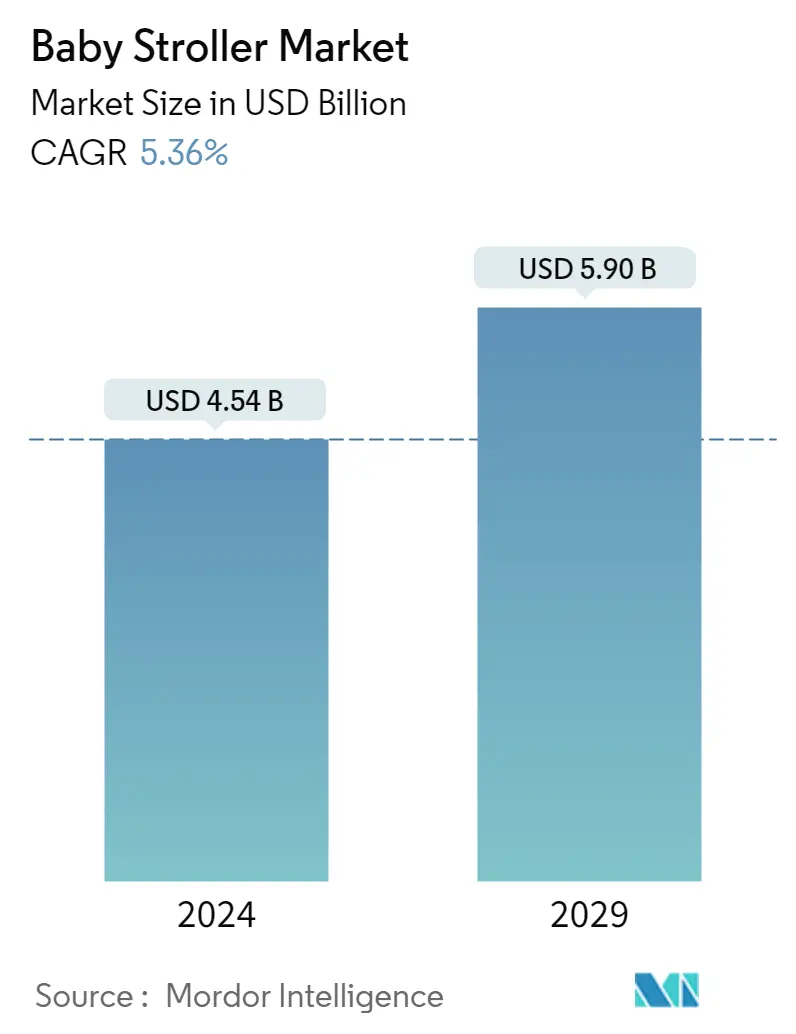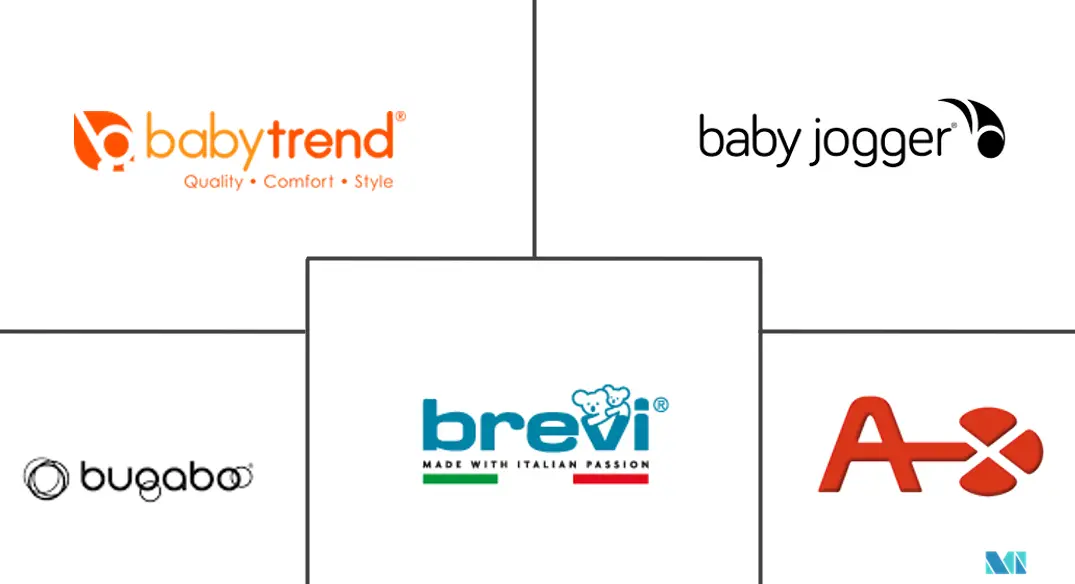Market Size of Baby Stroller Industry

| Study Period | 2019 - 2029 |
| Market Size (2024) | USD 4.54 Billion |
| Market Size (2029) | USD 5.90 Billion |
| CAGR (2024 - 2029) | 5.36 % |
| Fastest Growing Market | Asia-Pacific |
| Largest Market | North America |
Major Players
*Disclaimer: Major Players sorted in no particular order |
Need a report that reflects how COVID-19 has impacted this market and its growth?
Baby Stroller Market Analysis
The Baby Stroller Market size is estimated at USD 4.54 billion in 2024, and is expected to reach USD 5.90 billion by 2029, growing at a CAGR of 5.36% during the forecast period (2024-2029).
Due to travel bans and lockdowns that prevented individuals from leaving their homes, the COVID-19 effect had a detrimental influence on the baby stroller business. Due to its limited utility at the time, stroller sales have decreased as a result. Over the past year, online sales platforms have experienced significant growth. Players in the sector are strengthening their online presence as a result. During the pandemic, sales of infant products in offline retailers first decreased, but with time, infant product sales on internet shopping platforms progressively increased.
Over the medium term, features of the product such as convenience, ease of use, and availability of the product in different price ranges are likely to drive the usage of baby strollers around the world. Also, customization options and multi-functional features offered by the leading players in the industry are attracting more millennials to purchase the product. The development of the market is being supported by a number of intelligent features offered by the manufacturers using technological advancements, such as a climate-controlled bassinet, feeding bottle warmer, automatic rocking chair, automatic power folding, an electric locker, music, webcams, and a microphone that made parenting simple.
Moreover, the increased adoption of prams by consumers has helped raise the adoption of baby strollers. New product innovation by manufacturers has introduced multi-functional convertible strollers. For instance, Contours Bliss 4-in-1 convertible stroller system offered by Kolcraft Enterprises, Inc. can be converted from pram to stroller and vice versa.
Baby Stroller Industry Segmentation
A baby stroller is a small chair having wheels, suitable for a small child to sit in and be pushed around. Baby Stroller Market is segmented by type, buyer type, distribution channel, and geography. By type, the market is segmented into standard, all-terrain, double, compact and lightweight, and other strollers which include travel systems and modular strollers. By buyer type, the market is classified into infants and toddlers. By distribution channel, the market is segmented into offline retail stores and online retail stores. By geography, this report includes analysis for regions like North America, Europe, Asia-Pacific, South America, and the Middle East and Africa). The report offers market size and forecasts in value (USD million) for the above segments.
| By Type | |
| Standard | |
| All-Terrain | |
| Jogging | |
| Double | |
| Compact and Light weight | |
| Other Strollers (Travel systems and Modular strollers) |
| By End-User | |
| Infants | |
| Toddlers |
| By Distibution Channel | |
| Offline Retail Stores | |
| Online Retail Stores |
| By Geography | |||||||||
| |||||||||
| |||||||||
| |||||||||
| |||||||||
|
Baby Stroller Market Size Summary
The Baby Stroller Market is projected to experience substantial growth in the coming years. This surge is attributed to factors such as product convenience, ease of use, and availability in different price ranges. The market is also buoyed by the development of intelligent features like climate-controlled bassinets, automatic rocking chairs, and webcams, which simplify parenting. The increased adoption of prams and innovative multi-functional convertible strollers further fuels the market expansion. Despite the initial hit from the COVID-19 pandemic, the baby stroller industry has rebounded, with online sales platforms witnessing significant growth. The market's recovery is also driven by increasing consumer spending on baby care products, with parents prioritizing quality and safety. The growing popularity of ergonomically designed baby strollers and lightweight baby carriers is expected to propel the market growth further. Moreover, the market is consolidated, with major players focusing on increasing their footprint globally through product launches, competitive pricing, and establishing their online presence.
Explore MoreBaby Stroller Market Size - Table of Contents
-
1. MARKET DYNAMICS
-
1.1 Market Drivers
-
1.2 Market Restraints
-
1.3 Porter's Five Force Analysis
-
1.3.1 Threat of New Entrants
-
1.3.2 Bargaining Power of Buyers/Consumers
-
1.3.3 Bargaining Power of Suppliers
-
1.3.4 Threat of Substitute Products
-
1.3.5 Intensity of Competitive Rivalry
-
-
-
2. MARKET SEGMENTATION
-
2.1 By Type
-
2.1.1 Standard
-
2.1.2 All-Terrain
-
2.1.3 Jogging
-
2.1.4 Double
-
2.1.5 Compact and Light weight
-
2.1.6 Other Strollers (Travel systems and Modular strollers)
-
-
2.2 By End-User
-
2.2.1 Infants
-
2.2.2 Toddlers
-
-
2.3 By Distibution Channel
-
2.3.1 Offline Retail Stores
-
2.3.2 Online Retail Stores
-
-
2.4 By Geography
-
2.4.1 North America
-
2.4.1.1 United States
-
2.4.1.2 Canada
-
2.4.1.3 Mexico
-
2.4.1.4 Rest of North America
-
-
2.4.2 Europe
-
2.4.2.1 United Kingdom
-
2.4.2.2 Germany
-
2.4.2.3 Spain
-
2.4.2.4 France
-
2.4.2.5 Italy
-
2.4.2.6 Russia
-
2.4.2.7 Rest of Europe
-
-
2.4.3 Asia-Pacific
-
2.4.3.1 China
-
2.4.3.2 Japan
-
2.4.3.3 India
-
2.4.3.4 Australia
-
2.4.3.5 Rest of Asia-Pacific
-
-
2.4.4 South America
-
2.4.4.1 Brazil
-
2.4.4.2 Argentina
-
2.4.4.3 Rest of South America
-
-
2.4.5 Middle East & Africa
-
2.4.5.1 Saudi Arabia
-
2.4.5.2 South Africa
-
2.4.5.3 Rest of Middle East & Africa
-
-
-
Baby Stroller Market Size FAQs
How big is the Baby Stroller Market?
The Baby Stroller Market size is expected to reach USD 4.54 billion in 2024 and grow at a CAGR of 5.36% to reach USD 5.90 billion by 2029.
What is the current Baby Stroller Market size?
In 2024, the Baby Stroller Market size is expected to reach USD 4.54 billion.
